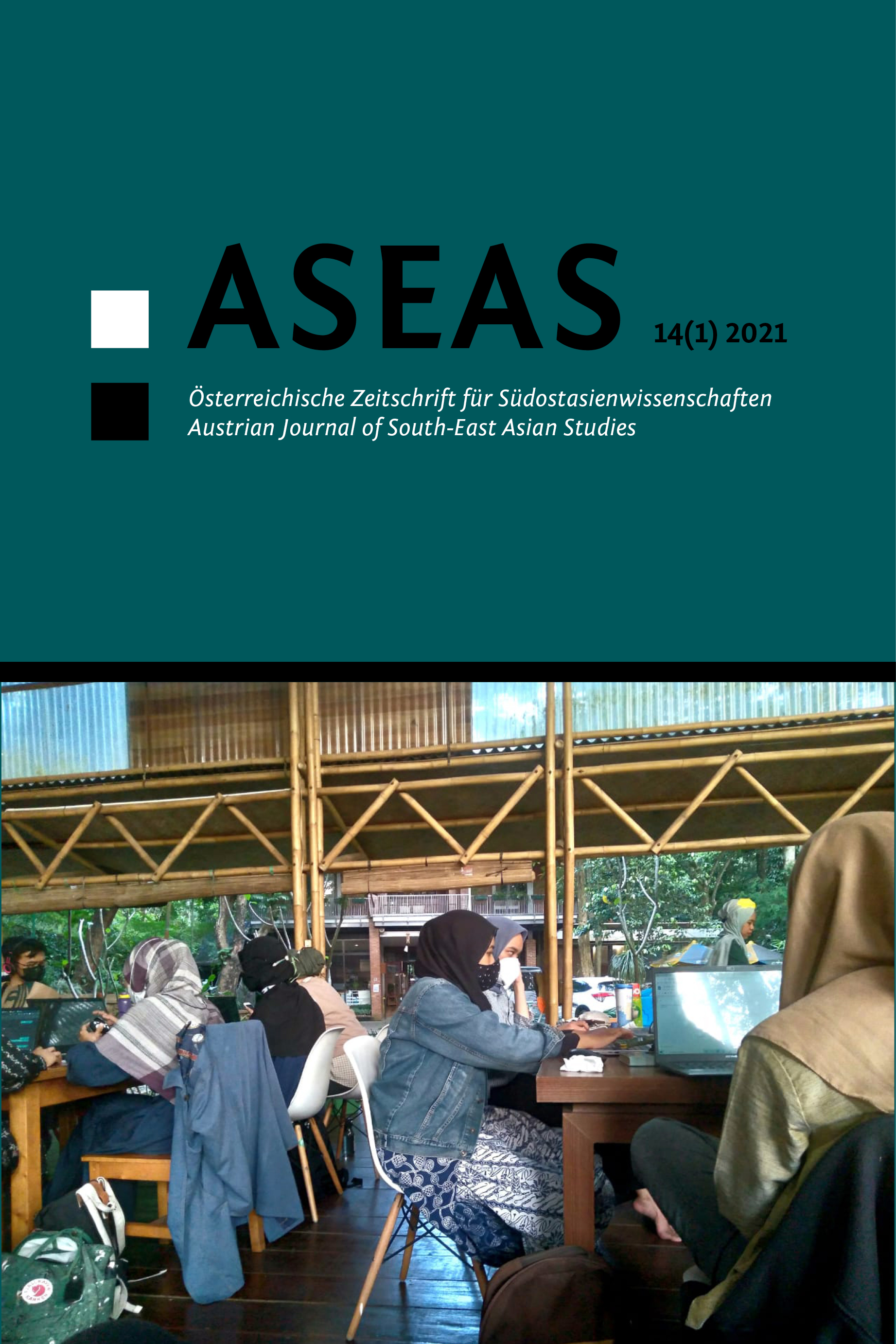Marginalized Minorities in Malaysia? A Case Study of a Demolished Estate Hindu Temple in Penang
DOI:
https://doi.org/10.14764/10.ASEAS-0053Keywords:
Penang, Malaysia, Hindu temple demolition, Hindus, religious minorityAbstract
In the literature, Malaysian Indians, as minorities, are marginalized and discriminated against, while their agency is either conspicuously lacking or one-dimensional. As a result, the mainstream discourse concerning Malaysian Indians is discursive and renders them subordinate. I argue that despite the marginalization and discrimination, grassroots Malaysian Indian Hindus are not powerless. With a case study of a demolished estate Hindu temple in Penang, I unpack their agential compliance and lack of confrontation when the state government destroyed their community temple. Their agential responses reflect their diverse political and social experiences as minorities and the myriad ways of interpreting the political rivalry between the ruling federal and opposition-led state government. Analysis of the case study is derived from ethnography and in-depth interviews with the estate Hindus.
References
Appadurai, A., & Breckenridge, C. A. (1976). The South Indian Temple: Authority, honour and redistribution. Contributions to Indian Sociology, 10(2), 187-211.
Arasaratnam, S. (1979). Indians in Malaysia and Singapore. Oxford University Press.
Arasaratnam, S. (2006). Malaysian Indians: The formation of incipient society. In K. S. Sandhu & A. Mani (Eds.), Indian communities in Southeast Asia (pp. 190-211). Institute of Southeast Asian Studies. (Original work published 1993)
Asad, T. (2009). Genealogies of religion. Discipline and reasons of power in Christianity and Islam. John Hopkins University Press.
Chanderbali, D. (2008). Indian indenture in the straits settlements, 1872-1910. Peepal Tree.
Gill, S. K., & Gopal, N. D. (2010). Understanding Indian religious practice in Malaysia. Journal of Social Sciences, 25(1-2-3), 135-146.
Hazis, F. S. (2015). Patronage, power and prowess: Barisan Nasional’s equilibrium dominance in east Malaysia. Kajian Malaysia: Journal of Malaysian Studies, 33(2), 1-24.
Kaur, A. (2012). Labour brokers in migration: Understanding historical and contemporary transnational migration regimes in Malaya/Malaysia. International Review of Social History, 57(S20), 225-252.
Kent, A. (2005). Divinity and diversity: A Hindu revitalization movement in Malaysia (Vol. 98). Nias Press.
Khoo, K. K. (2009). The emergence of plural communities in the Malay Peninsula before 1874. In T. G. Lim, A. Gomes, & R. Azly (Eds.), Multiethnic Malaysia: Past, present, and future (pp. 14-16). Strategic Information and Research Development Centre (SIRD).
Lal, V. (2006). Multiculturalism at risk: The Indian minority in Malaysia. Economic and Political Weekly, 3764-3765.
Lee, R. L. M. (1988). Patterns of religious tension in Malaysia. Asian Survey, 28(4), 400-418.
Loh, F. K. W. (2010). Restructuring federal-state relations in Malaysia: From centralised to co-operative federalism? The Round Table, 99(407), 131-140.
Mahmood, S. (2011). Politics of piety: The Islamic revival and the feminist subject. Princeton University Press.
Mahmood, S. (2012). Religious freedom, the minority question, and geopolitics in the Middle East. Comparative Studies in Society and History, 54(2), 418-446.
Mokhtar, T. M. (2008). The twelfth general elections in Malaysia. Intellectual Discourse, 16(1), 89-100.
Müller, D. M. J. I. (2015). Islamic politics and popular culture in Malaysia: Negotiating normative change between Shariah Law and electric guitars. Indonesia and the Malay World, 43(127), 318-344.
Noor, F. A. (2008). The Hindu Rights Action Force (HINDRAF) of Malaysia: Communitarianism across borders? S. Rajaratnam School of International Studies Press.
Polak, H. S. L. (1941). Indian emigration overseas. Journal of the Royal Society of Arts, 89(4578), 85-101.
Prorok, C. V. (2015). The materiality of diasporic identity: Hindu temples in Trinidad and Malaysia. In P. P. Kumar (Ed.), Indian diaspora. Socio-cultural and religious worlds (pp. 252-279). Brill.
Ramanathan, K. (1995). Hindu religion in an Islamic state: The case of Malaysia. Doctoral thesis, Universiteit van Amsterdam, Amsterdam.
Sandhu, K. S. (1969). Indians in Malaya: Some aspects of their immigration and settlement (1786-1957). Cambridge University Press.
Scott, J. C. (1972). Patron-client politics and political change in Southeast Asia. The American Political Science Review, 66(1), 91-113.
Scott, J. C. (1990). Domination and the arts of resistance: Hidden transcripts. Yale University Press.
Scott, J. C. (2008). Weapons of the weak: Everyday forms of peasant resistance. Yale university Press.
Simandjuntak, D. (2012). Gifts and promises: Patronage democracy in a decentralised Indonesia. European Journal of East Asian Studies, 11(1), 99-126.
Sinha, V. (2011). The Mohammedan and Hindu endowments ordinance, 1905: Recourse to Legislation. In, Religion-State Encounters in Hindu Domains (Vol. 1, pp. 83-124). Springer Netherlands.
The Star Online. (2016a, 29 March). Assurance sought that school won’t make way for development. The Star Online. http://www.thestar.com.my/news/nation/2016/03/29/assurance-sought-that-schoolwont-
make-way-for-development/
The Star Online. (2016b, 16 July). Build school before taking land, PDC told. The Star Online. http://www.thestar.com.my/news/nation/2016/07/16/build-school-before-taking-land-pdc-told/
van Klinken, G., & Berenschot, W. (2014). In search of Middle Indonesia: Middle classes in provincial towns. Brill.
Willford, A. C. (2002). “Weapons of the meek”: Ecstatic ritualism and strategic ecumenism among Tamil Hindus in Malaysia. Identities: Global Studies in Culture and Power, 9(2), 247-280.
Willford, A. C. (2015). Tamils and the haunting of justice: History and recognition in Malaysia's plantations. NUS Press.
Downloads
Published
Issue
Section
License
Copyright (c) 2021 Society for South-East Asian Studies (SEAS)

This work is licensed under a Creative Commons Attribution-NonCommercial-NoDerivatives 4.0 International License.
For all articles published in ASEAS before December 2014 and after July 2022, copyright is retained by the authors. For articles published between January 2015 and June 2022, the Society for South-East Asian Studies (SEAS) is the copyright holder. Articles published in ASEAS before December 2019 are licensed under the following Creative Commons License: Attribution-NonCommercial-NoDerivs 3.0 Unported. Articles published after that date are licensed under the following Creative Commons License: Attribution-NonCommercial-NoDerivs 4.0 International. In both cases, this means that everybody is free to share (to copy, to distribute, and to transmit the work) under the following conditions:
-
Attribution — You must give appropriate credit, provide a link to the license, and indicate if changes were made. You may do so in any reasonable manner, but not in any way that suggests the licensor endorses you or your use.
-
NonCommercial — You may not use the material for commercial purposes.
-
NoDerivatives — If you remix, transform, or build upon the material, you may not distribute the modified material.


